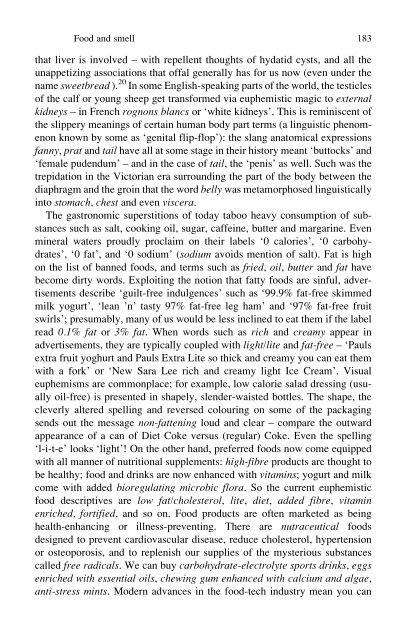Forbidden Words: Taboo and the Censoring of Language
Forbidden Words: Taboo and the Censoring of Language
Forbidden Words: Taboo and the Censoring of Language
Create successful ePaper yourself
Turn your PDF publications into a flip-book with our unique Google optimized e-Paper software.
Food <strong>and</strong> smell 183<br />
that liver is involved – with repellent thoughts <strong>of</strong> hydatid cysts, <strong>and</strong> all <strong>the</strong><br />
unappetizing associations that <strong>of</strong>fal generally has for us now (even under <strong>the</strong><br />
name sweetbread ). 20 In some English-speaking parts <strong>of</strong> <strong>the</strong> world, <strong>the</strong> testicles<br />
<strong>of</strong> <strong>the</strong> calf or young sheep get transformed via euphemistic magic to external<br />
kidneys – in French rognons blancs or ‘white kidneys’. This is reminiscent <strong>of</strong><br />
<strong>the</strong> slippery meanings <strong>of</strong> certain human body part terms (a linguistic phenomenon<br />
known by some as ‘genital flip-flop’): <strong>the</strong> slang anatomical expressions<br />
fanny, prat <strong>and</strong> tail have all at some stage in <strong>the</strong>ir history meant ‘buttocks’ <strong>and</strong><br />
‘female pudendum’ – <strong>and</strong> in <strong>the</strong> case <strong>of</strong> tail, <strong>the</strong> ‘penis’ as well. Such was <strong>the</strong><br />
trepidation in <strong>the</strong> Victorian era surrounding <strong>the</strong> part <strong>of</strong> <strong>the</strong> body between <strong>the</strong><br />
diaphragm <strong>and</strong> <strong>the</strong> groin that <strong>the</strong> word belly was metamorphosed linguistically<br />
into stomach, chest <strong>and</strong> even viscera.<br />
The gastronomic superstitions <strong>of</strong> today taboo heavy consumption <strong>of</strong> substances<br />
such as salt, cooking oil, sugar, caffeine, butter <strong>and</strong> margarine. Even<br />
mineral waters proudly proclaim on <strong>the</strong>ir labels ‘0 calories’, ‘0 carbohydrates’,<br />
‘0 fat’, <strong>and</strong> ‘0 sodium’ (sodium avoids mention <strong>of</strong> salt). Fat is high<br />
on <strong>the</strong> list <strong>of</strong> banned foods, <strong>and</strong> terms such as fried, oil, butter <strong>and</strong> fat have<br />
become dirty words. Exploiting <strong>the</strong> notion that fatty foods are sinful, advertisements<br />
describe ‘guilt-free indulgences’ such as ‘99.9% fat-free skimmed<br />
milk yogurt’, ‘lean ’n’ tasty 97% fat-free leg ham’ <strong>and</strong> ‘97% fat-free fruit<br />
swirls’; presumably, many <strong>of</strong> us would be less inclined to eat <strong>the</strong>m if <strong>the</strong> label<br />
read 0.1% fat or 3% fat. When words such as rich <strong>and</strong> creamy appear in<br />
advertisements, <strong>the</strong>y are typically coupled with light/lite <strong>and</strong> fat-free – ‘Pauls<br />
extra fruit yoghurt <strong>and</strong> Pauls Extra Lite so thick <strong>and</strong> creamy you can eat <strong>the</strong>m<br />
with a fork’ or ‘New Sara Lee rich <strong>and</strong> creamy light Ice Cream’. Visual<br />
euphemisms are commonplace; for example, low calorie salad dressing (usually<br />
oil-free) is presented in shapely, slender-waisted bottles. The shape, <strong>the</strong><br />
cleverly altered spelling <strong>and</strong> reversed colouring on some <strong>of</strong> <strong>the</strong> packaging<br />
sends out <strong>the</strong> message non-fattening loud <strong>and</strong> clear – compare <strong>the</strong> outward<br />
appearance <strong>of</strong> a can <strong>of</strong> Diet Coke versus (regular) Coke. Even <strong>the</strong> spelling<br />
‘l-i-t-e’ looks ‘light’! On <strong>the</strong> o<strong>the</strong>r h<strong>and</strong>, preferred foods now come equipped<br />
with all manner <strong>of</strong> nutritional supplements: high-fibre products are thought to<br />
be healthy; food <strong>and</strong> drinks are now enhanced with vitamins; yogurt <strong>and</strong> milk<br />
come with added bioregulating microbic flora. So <strong>the</strong> current euphemistic<br />
food descriptives are low fat/cholesterol, lite, diet, added fibre, vitamin<br />
enriched, fortified, <strong>and</strong> so on. Food products are <strong>of</strong>ten marketed as being<br />
health-enhancing or illness-preventing. There are nutraceutical foods<br />
designed to prevent cardiovascular disease, reduce cholesterol, hypertension<br />
or osteoporosis, <strong>and</strong> to replenish our supplies <strong>of</strong> <strong>the</strong> mysterious substances<br />
called free radicals. We can buy carbohydrate-electrolyte sports drinks, eggs<br />
enriched with essential oils, chewing gum enhanced with calcium <strong>and</strong> algae,<br />
anti-stress mints. Modern advances in <strong>the</strong> food-tech industry mean you can

















